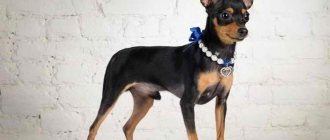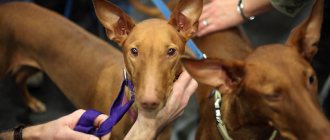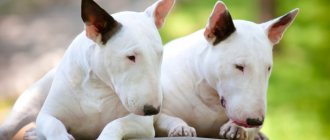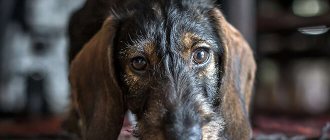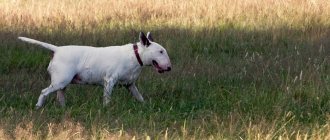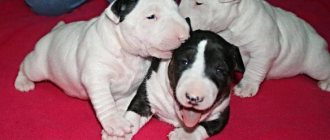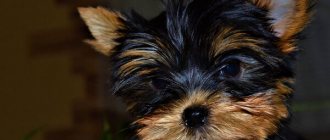Rumors about the bloodthirstiness of bull terriers stem from the history of the formation of the breed, created for brutal dog fighting.
In the modern world, you can often find stories about how a bull terrier attacked people, its own owner or other animals.
Often this turns out to be exaggerated information or we are talking about representatives of other breeds, such as pit bull, Staffordshire terrier, bulldog, which also belong to fighting breeds, and in the eyes of the public have long turned into ferocious, uncontrollable monsters.
To understand why a bull terrier is dangerous, you need to look at the main traits of its character.
Dog Temperament
Owners of animals of this breed speak of them as incredibly loyal and loving pets who are always ready to protect their owner.
They treat strangers calmly and love to be in public places with an abundance of impressions.
An active character requires constant movement, games and a splash of emotions. But this is also where the second characteristic feature of bull terriers comes from.
A distinctive feature of bull terriers is stubbornness, which manifests itself constantly: in the home environment, in upbringing, in defining boundaries, in the family hierarchy.
Bull Terriers have a pronounced dominant trait; they strive to take a leading position in the family.
This manifests itself in every little detail, so the owner will have to be patient in order to mark the dog’s place in a timely manner.
The owner must have a strong character: having created a ban once, it should be strictly adhered to, and the rest of the family members, including children, should also be taught to do so.
Why are they afraid?
People themselves are to blame for creating the ominous aura of this breed.
The first reason for this was the fact that bull terriers in our country were bred without strict selection.
Often, bitches that had not reached normal physiological development were allowed to breed, or during each heat for several years, which is also prohibited by the FCI standard.
The result of such work aimed at enrichment was the loss of the characteristic features of the breed and the psychological instability of the dogs.
Losing such characteristic features as calmness and equanimity, bull terriers turn into cruel and aggressive animals with a steely grip and a desire to attack.
To avoid purchasing such a specimen for personal possession, it is necessary to carefully study the pedigree of the parents of the selected puppy and reviews of the owners of the kennel.
You should not thoughtlessly purchase a puppy at the “bird market”, helping unscrupulous breeders.
The second reason to be afraid of bull terriers is, again, people. Often, a large fighting dog is acquired by people with a tendency towards cruelty and aggression.
Such owners purposefully develop negative traits in animals, crippling the dog’s psyche. The natural result of this behavior is inadequacy and uncontrollability, from which both those around and the owner himself can suffer.
But often, this happens unconsciously: when a puppy or an older dog gets into a fight, the owners do not prevent such behavior, or they themselves are afraid of it.
Having shown an evil character, and not stopped by the owner, the bull terrier will do this again and again.
Cautious and responsible owners of representatives of this breed try to avoid situations where the animal might get into a fight.
The puppy should not be limited in playing with other animals, but as soon as aggressive traits appear, the activity is stopped.
If a collision between two adult dogs could not be avoided, you should not separate them by kicking them, dousing them with water, or pulling them away with your hands.
The leash of a dog that has been attacked is attached to a durable object that can withstand the pressure of the animal. As soon as the leash is tight, a belt, leash or scarf is placed around the second dog’s neck, squeezing the windpipe.
If this cannot be accomplished, then they sharply tear off the rear part of the animal’s body from the ground, and press it between their knees so that it loses the ability to fight, and hold the collar with their hand.
With the second hand they squeeze the throat, and then the dog will unclench its jaws. It is strictly forbidden to open them manually; it will all end in serious bites.
History of the origin of bull terriers
The ancestors of bull terriers are dogs that were used for fighting. In the Middle Ages, bloody sport was popular in England - they set dogs against large animals: bulls, bears, wild boars. There was a fighting pit in every English village. Strong, angry, hardy and fast small dogs were used for fighting. They were specially selected from English bulldogs.
After a law prohibiting bullfighting was passed at the beginning of the 19th century, lovers of this bloody spectacle switched to dogs. Fighting breeds began to be bred, more active and agile. The result was the Bull and Terrier, which combined the ferocity and powerful grip of the Bulldog with the energy of the Terrier. They were ready to fight to the bitter end, did not feel pain, and their bites were often fatal.
The modern bull terrier breed appeared in the middle of the 19th century. The breeder was James Hinks. He tried to improve the external characteristics of the bull and terrier, to breed a more attractive dog. English bulldogs, white terriers, Amstaffs, even greyhounds and Dalmatians were used in the selection. Compared to the Bull and Terrier, the new breed had an elongated head, a long body, and the dewlap on the neck and folds of skin disappeared. The result was an elegant, unusual dog with developed intelligence. But she still has the traits of fighting breeds:
- powerful jaws that cannot be unclenched; the bite creates a pressure of 25 atmospheres;
- ferocious character;
- excellent response;
- small strong body;
- perseverance and perseverance;
- strength, endurance.
At that time, bull terriers were white; other colors were not allowed. The new breed was recognized at the end of the 19th century and became popular. At the beginning of the 20th century, amateur clubs began to be created around the world. This dog went from being a fighting dog to being a companion. But the history of the new breed had many problems. At first, crossing white individuals with colored individuals was not allowed. This almost brought the breed to the brink of destruction - white dogs began to be born with genetic diseases. Then the ban on ear cropping forced breeders to look for a way to make them stand up. And now in some countries this breed has been completely banned. These are Germany, Ireland, Switzerland, Spain, Israel.
Bull terriers are not prohibited in Russia. The breed became popular in the 90s, but immediately acquired a negative reputation. This is due to the fact that these dogs were bred by inexperienced dog breeders. They were raised incorrectly, even set against them. Therefore, many people have the opinion that the bull terrier is an angry dog that is inadequate and can attack at any moment. Interesting historical pictures showing the characteristics of bull terriers:
Historical photo
Historical photo
Basics of education
In order to save others and yourself from the aggressiveness and cruelty of bull terriers, it is important to approach his upbringing correctly.
It is based on love for your pet. If you approach training and maintenance with patience and care, then the chance of raising an unbalanced animal tends to zero.
It should be remembered that the manifestation of aggressiveness and cruelty towards an animal will invariably lead to the same response.
To release energy, you should regularly walk the animal and give it the opportunity to play.
Owners of bull terriers and other fighting breeds should know that if the dog grows up angry and aggressive, then in most cases they themselves are to blame.
Most often this happens due to a desire to save money when a dog is purchased without documents and with an unknown mental state; or due to lack of proper education and care.
For your own peace of mind and the peace of those around you, you need to take your bull terrier through an obedience course, teach him to walk on a leash and muzzle, without taking them off in public places.
Breed standard
The Bull Terrier is a well-built dog with well-developed muscles and a compact body. The height of males at the withers is 30-45 cm, weight is 18-30 kilograms. Bitches are much smaller.
Description of the Bull Terrier breed:
- The skull is oval in shape. The head is deep and long. The area between the ears is flat.
- The jaws are strong and powerful. Scissor bite.
- The lips are dry, tightly adjacent to each other.
- The eyes are small, slanted, and shaped like triangles. In a state of excitement they become more expressive and rounded.
- The ears are triangular in shape, medium in size, and stand upright.
- The nose is wide and blunt. The lobe is down, black.
- Neck with prominent muscles, wide, tapering towards the head.
- The back is flat and straight.
- The chest is deep and wide.
- The limbs are strong and muscular. The front ones are more developed. The paws are round.
- The tail is set low and short. Thick at the base, tapering towards the tip.
Bull Terriers have short coats that lie close to the skin. Smooth and hard to the touch. As for colors, ideally it should be solid white. White bull terriers are more valuable. Plain black, colored as standard is allowed.
Photo gallery
Despite the ominous stories, you should know that a bull terrier, like any other dog, can become a kind and loving friend to you - it all depends on you.
Diseases and health problems
Despite their massive, menacing appearance, representatives of the breed get sick more often than other dogs. Small and poorly developed kidneys lead to the appearance of hereditary nephritis, most often manifested at an early age. Due to insufficient functioning of the kidney filters, the level of protein in the urine increases. Such individuals rarely live beyond 3 years.
Another common problem is deafness in one or both ears. White individuals are more susceptible to this disease. Colored quadrupeds may be deaf in one ear. Defects in the structure of the heart lead to heart failure.
Interesting fact: White Bull Terriers are prone to skin sensitivity, which causes irritation, fungal diseases, and rashes. Dust, mold and detergents can cause contact allergies. If skin diseases occur, timely treatment is recommended.
Since representatives of the Bull Terrier breed do not have an undercoat that provides protection from cold and dampness, long stays outside can lead to colds. After a walk in rainy weather, you need to bring the animal into the house, dry it and warm it up.
On average, the life expectancy of dogs is 10-11 years. Although there are also individuals who live up to 17. Some babies under the age of one year may develop acute lameness, which is caused by rapid weight gain.
Insufficiently developed muscles cannot withstand the heavy loads that occur when performing large jumps, sharp turns or stopping at full gallop. The joints are unable to cope with the torques caused by body weight. Because of this, increased physical stress on a growing body should be avoided.
